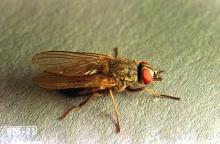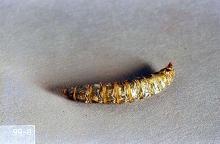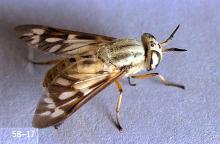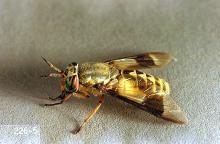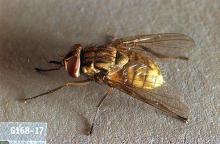Including
Black fly (Simulidae)
Deer fly (Chrysops spp.)
Horn fly (Haematobia irritans)
Horse fly (Tabanus spp.)
Stable fly (Stomoxys calcitrans)
Pest description and damage There are several kinds of flies that suck blood from horses. These include: horn flies, horse flies, deer flies, stable flies, and in some cases, black flies. The primary concern regarding these flies is annoyance to the horse.
Note: Dusts may be the preferred treatment. Horses often react violently to higher spray pressures. It may be safer to apply dilute sprays with a sponge.
- butoxypolypropylene glycol (5%) (Endure sweat resistant spray)-Thoroughly brush the hair coat to remove loose dirt. Spray the entire body liberally. Reapply every 5 to 7 days. As protection builds up, reapply every 10-14 days. Not for use on horses intended for human consumption.
- coumaphos (emulsified)-Spray at 2.5 oz/4 gal. Apply to runoff. Repeat as necessary. Treat thoroughly all wounds and injuries. Do not apply to sick, convalescent, or stressed horses or to colts less than 3 months old. Do not apply with other medications or treatments or in stress situations. Do not allow contact with treated animals until their coats are dry. (RESTRICTED USE PESTICIDE: Acute Oral Hazard. For retail sale to and use only by certified applicators or persons under their direct supervision and only for those uses covered by the certification).
- coumaphos (flowable insecticide)-Spray at 1 quart/200 gal water and mix thoroughly. Apply for complete wetting to run-off. Do not spray more than six times per year. Do not make applications less than 10 days apart. (RESTRICTED USE PESTICIDE: Acute Oral Hazard. For retail sale to and use only by certified applicators or persons under their direct supervision and only for those uses covered by the certification).
- coumaphos (Co-ral Fly and Tick Spray)-Apply on-animal spray at 2 quarts/50 gal water or 5 oz/4 gal water. Treat all wounds thoroughly. Do not exceed six treatments per year. Allow at least 10 days between treatments. Not for use in horses intended for human consumption.
- cyromazine (Solitude IGR Feed-Through Fly Control 2.12%)-Apply 0.5 oz to daily ration regardless of horse breed or size. The 0.5 oz serving provides 300 mg cyromazine/horse per day. Begin feeding before flies begin to appear and feed into the fall until cold weather inhibits fly development. Inhibits larvae development. Specific to flies, so not harmful to other horses, animals or insects in pastures that contain manure from treated horses. Not for use in horses intended for food purposes.
- cypermethrin 0.15% + pyrethrins 0.20%-Spray or wipe entire body. Use on clean dry horses. Reapply every 5 to 7 days, as protection builds; reapply every 10 to 14 days. Not for use in horses intended for human consumption. Do not use on foals under three (3) months of age.
- diflubenzuron (Simplifly with LarvaStop Feed-Through Fly Control 0.24%)-Top dress grain daily to provide 6.8 mg of diflubenzuron/100 lb of body weight. Daily dosage table provided on label. Effective against larvae, not existing adult flies. Not for use in horses intended for food purposes.
- methoprene (0.27%) + pyrethrins (0.2%) + PBO (0.37%) + attractant (Ovitrol Plus II)-Spray directly to horse's coat until moist but before runoff, being careful to avoid the eyes. Spray every 2 months to aid in fly control. Do not treat horses intended for food purposes. Consult a veterinarian before using on debilitated, aged, pregnant, nursing or horses on medication.
- MGK 264 (N-Octyl bicycloheptene dicarboximide) (21%) + permethrin 7.6% + piperonyl butoxide 14% (Prozap War Paint Insecticide Paste)-ADULT HORSES ONLY. Turn the applicator wheel ¼ turn to bring 2 grams of paste to the top of the applicator. Apply a 1-inch by 4-inch stripe down the front cannon of the leg, where insects tend to irritate. Repeat for the other three legs. The pesticide is released over a period of weeks. DO NOT REPEAT TREATMENT FOR 7 DAYS and then only if needed. Do not apply this product with a sponge. Use the applicator stick only. Do not apply to a wet animal as the paste will not adhere. Once applied to the hair, it cannot be wiped off; therefore do not use within one to two weeks before a show or event as it will affect appearance. If local irritation occurs, discontinue use. If irritation persists, consult a veterinarian. Not for horses intended for food.
- permethrin 10%-Apply at 1.28 oz/1 gal water for severe infestations. Spray to thoroughly cover the entire animal. Do not use on foals under three (3) months of age. Do not ride within 24 hr of application.
- permethrin 10%-Apply at 0.64 oz/1 gal water for normal infestations. Spray to thoroughly cover the entire animal. Do not use on foals under three (3) months of age. Do not ride within 24 hr of application.
- permethrin (7.4%) + piperonyl butoxide (7.4%)-Pour-on 8 to 16 ml to back and face being cautious of eyes. Pour-on to MATURE horses only. Wipe-on 8 to 16 ml using a damped applicators mitt or towel. Wipe-on can be applied to mature horses and foals. Repeat as needed, but not more than once every two weeks.
- pyrethrins + piperonyl butoxide synergist-Spray or wipe entire body. Follow manufacturer's directions. No limit. Repeat as needed.
- pyrethrin (0.1%) + piperonyl butoxide (1.0%) + butoxypolypropylene glycol (7.5%) (Bronco Gold Equine Fly Spray)-As a spray apply a fine mist to and around the horse. Do not wet the horse's skin or exceed 2 ounces per application. As a wipe on moisten a soft cloth and rub over the hair. Give special attention to the legs, shoulders, neck and facial area. Do not use on horses intended for slaughter. Do not use on foals under three (3) months of age.
- zeta-cypermethrin (0.075%) + piperonyl butoxide (0.15%) (Python Insecticide Dust)-Apply up to 2 oz per animal evenly in the hair over the head, ears, neck, shoulders, back and tailhead. Do not apply more often than every 3 days. Never use on dogs or cats.


